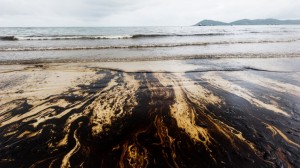The Future of Oil spill clean-ups
Each time I hear about an oil spill, my heart clenches. It really hurts to imagine the butterfly effect of one unfortunate event leading to another. Most of the time I think to myself, “the damage is done, I really hope I don’t hear about another one any time soon.” After reading this article, I see some light in the future of cleaning up oil spills.
A new and improved version of a water-contaminant-absorbing sponge, specifically the carbon nanotube sponge (CNT), is tested to absorb more than 3.5 times the mass of its previous generation. This is how it works: the now larger 2cm porous sponge has added material of sulfur and iron. The added sulfur allows the sponges to expand to a bigger size, obviously to absorb more oil and be more efficient! You may wonder how in the world these tiny sponges can be retrieved once spread all over the ocean to work its magic. First of all, the porous nature of the sponge creates buoyancy on water. In addition, the iron inside the sponge makes the structure easier to control and allows for magnetic retrieval from the environment.
Ah, that explains things.
What’s next for the researchers is to test the toxicity of these sponges before looking into producing the CNT sponges on a commercial scale. I am really excited to see where this technology will take us to and I can’t wait until these sponges are launched!
Sources:
http://www.gizmag.com/carbon-nanotube-sponges/30511/
http://www.sciencedaily.com/releases/2014/01/140117090615.htm


Fascinating! It’s truly amazing some of the technology at our disposal these days. I learned about another prospect recently called geoengineering technology, which is meant to correct climate change. Some claim it might be our only hope if we cannot adequately reduce greenhouse gas emissions. But other environmentalists are concerned about inducing such a great manipulation of nature. Not so long ago, many people thought technology was the enemy of environmentalism, and thought the only way to save the planet was for humanity to take a complete simplistic approach to their lifestyle. But I think it might be a little late for that. So technologies such as this could be a very probable solution.
Article on geoengineering technology: http://walrusmagazine.com/articles/2011.06-science-climate-controlled/
Hi Jennifer, this sounds like a great technological approach to cleaning up oil spills. You might also be interested in thinking about how individual consumers can be persuaded to donate to help in clean up efforts or even pro-active efforts to reduce the chances of spills – to that end, I think something called the identifiable victim effect is potentially relevant. Basically, it shows that people have greater sympathy and are more willing to help victims of a disaster when those victims are identifiable rather than merely statistical (i.e. images of a bird drowning in oil vs. abstract numbers of victims). More info here: http://en.wikipedia.org/wiki/Identifiable_victim_effect
Also, it’s interesting to note that people tend to be ‘scope insensitive,’ meaning that their sympathy and willingness to help doesn’t increase proportionally with the scale of the disaster. In one study, people were asked how much they’d be willing to pay to save either 2000, 20,000, or 200,000 birds from oil spills, and the amounts were not significantly different from each other.
I think that technology definitely has a huge role to play in moving us towards sustainability, but people have to be willing to pay for and use those technologies, which is why understanding consumer behaviour is so important!